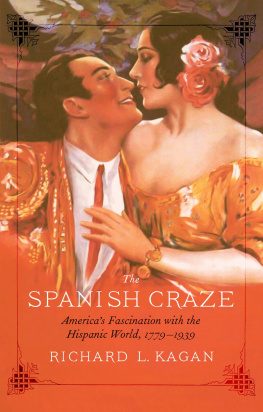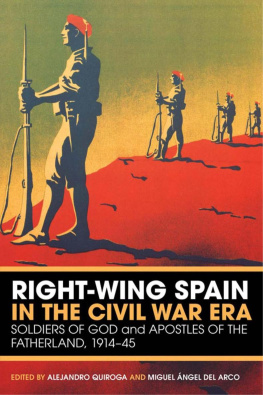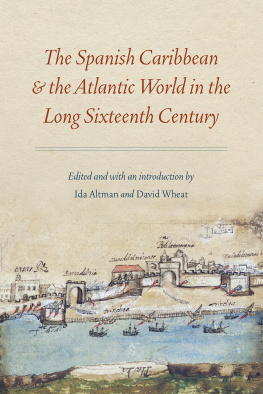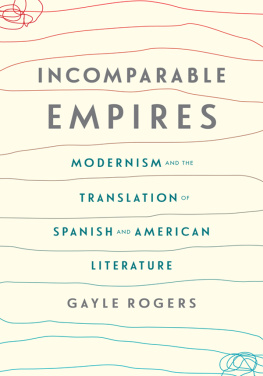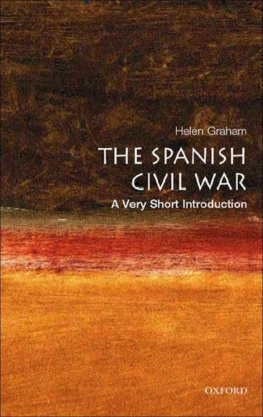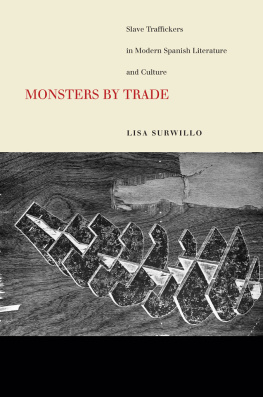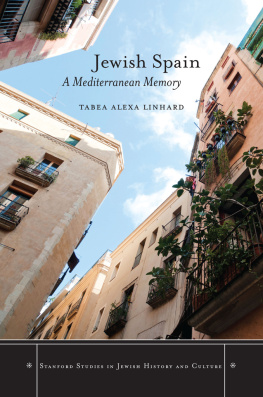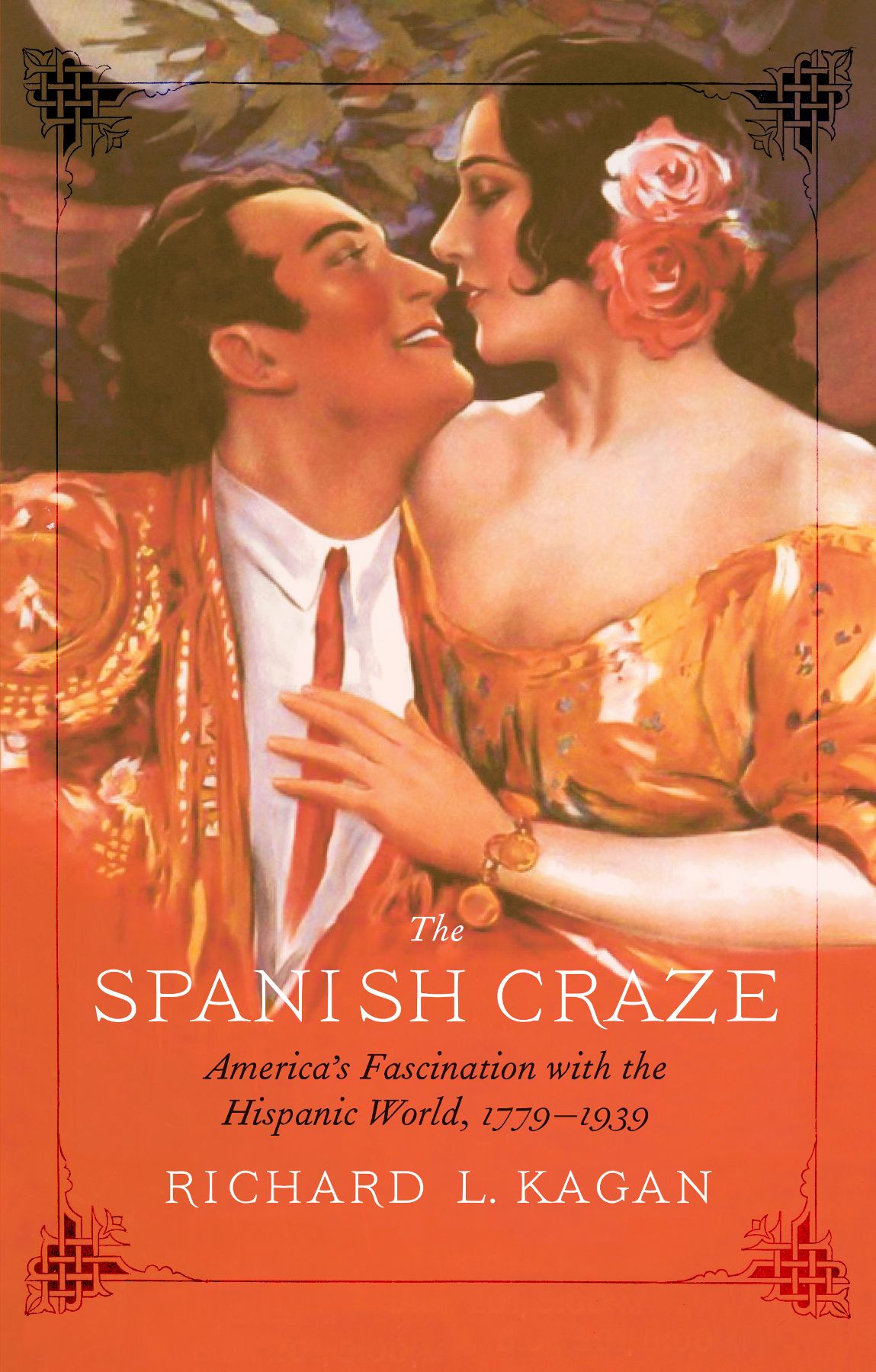
The historical evolution of Hispanism is particularly relevant at this time, when the United States government is again at metaphorical battle with the Hispanic world and it Hispanic population. By understanding this history, U.S. citizens today will be able to better assess and make decisions about how to move forward in the future.
M. Elizabeth Boone, professor of the history of art, design, and visual culture at the University of Alberta and author of Vistas de Espaa: American Views of Art and Life in Spain, 18601914
The Spanish Craze is distinct. It not only encompasses an ambitious span of time, but it also provides novel and captivating glimpses into [discrete] faces of Hispanism. This book is very expansive, wonderfully original, and well narrated.
John Nieto-Phillips, associate professor of history at Indiana University, Bloomington, and author of The Language of Blood: The Making of Spanish-American Identity in New Mexico, 1880s1930s
The Spanish Craze
Americas Fascination with the Hispanic World, 17791939
Richard L. Kagan
University of Nebraska Press | Lincoln
2019 by the Board of Regents of the University of Nebraska
Portions of chapter 2 are adapted from ideas originally expressed in The Invention of Junpero Serra and the Spanish Craze, in The Worlds of Junpero Serra: Historical Contexts and Cultural Representations, ed. Steven W. Hackel (Oakland: University California Press for the Huntington- USC Institute and Huntington Library, 2017) and Floridas Discovery of Spain, in La Florida: Five Hundred Years of Hispanic Presence, ed. Viviana Daz Balsera and Rachel A. May (Gainesville: University Press of Florida, 2014). Portions of chapter 4 are adapted from ideas originally expressed in The Spanish Craze in the United States: Cultural Entitlement and the Appropriation of Spains Cultural Patrimony, ca. 1890ca. 1930, Revista Complutense de Historia de Amrica 36 (2010): 3758.
Cover designed by University of Nebraska Press; cover image is from the interior.
All rights reserved
Library of Congress Cataloging-in-Publication Data
Names: Kagan, Richard L., 1943 author.
Title: The Spanish craze: Americas fascination with the Hispanic world, 17791939 / Richard L. Kagan.
Description: Lincoln: University of Nebraska Press, [2019] | Includes bibliographical references and index.
Identifiers: LCCN 2018032362
ISBN 9781496207722 (cloth: alk. paper)
ISBN 9781496211132 (epub)
ISBN 9781496211149 (mobi)
ISBN 9781496211156 (pdf)
Subjects: LCSH : United StatesCivilizationSpanish influences. | United StatesCivilizationHispanic influences. | SpainForeign public opinion, AmericanHistory. | United StatesRelationsSpain. | SpainRelationsUnited States.
Classification: LCC E 169.1 . K 215 2019 | DDC 327.73046dc23 LC record available at https://lccn.loc.gov/2018032362
The publisher does not have any control over and does not assume any responsibility for author or third-party websites or their content.
For Jonathan Brown
colleague, mentor, friend
Contents
Maps
Figures
Plates
Ten years ago, shortly after having presented a lecture on the collecting of Spanish Old Master art in the United States, I asked my friend and colleague Jonathan Brown a simple question: Jonathan, do you think its worth expanding my talk in a book? Never one to mince words, Jonathan responded, Go for it. For this reasonand there are many others I could addI am dedicating this book to Jonathan, arguably the worlds premier specialist in the art history of both Spain and its empire.
Jonathan apart, many others, far more than I can remember, have helped make this book possible. The list begins with the archivists and librarians at various institutions who assisted my research. In North America these institutions include the Art Institute of Chicago; Avery Library, Columbia University; Bancroft Library, University of California, Berkeley; Museum of Fine Arts, Boston; Braun Research Library, Los Angeles; Rhys Carpenter Library, Bryn Mawr College; Casa del Herrero, Montecito, California (where Robert Sweeney made a special trip to assist with my research); Charles Deering Library, Northwestern University; Deering Estate, Cutler, Florida; Four Arts Society, Palm Beach, Florida; Frick Art Reference Library, New York; Hispanic Society of America (there John ONeill, Patrick Lenaghan, and the director, Mitchell Codding, deserve a special expression of thanks); Houghton Library, Harvard University; Kennedy Library, California Polytechnic State University; Library of Congress; Milton S. Eisenhower Library, Johns Hopkins University; Metropolitan Museum of Art, New York; Royal Ontario Museum, Toronto; the New-York Historical Society; Philadelphia Museum of Art; Rauner Library, Dartmouth College; Shelburne Museum, Shelburne, New Hampshire; Southwest Collection, Texas Tech University; Stirling Library, Yale University; Fray Anglico Chvez History Library, Santa Fe, New Mexico; George A. Smathers Libraries, University of Florida; Special Collections, University of Miami Libraries; Van Pelt Library, University of Pennsylvania; Architectural and Design Collection, AD&A Museum, University of California, Santa Barbara; and West Palm Beach Historical Society, West Palm Beach, Florida. I am equally grateful for the assistance provided by the staff in various Spanish repositories. They include the Archivo General de la Administracin in Alcal de Henares, Barcelonas Casa de Amrica, and in Madrid the Archivo de Ministerio de Asuntos Extranjeros (now part of Archivo Histrico Nacional), Archivo General de Palacio Real, Museo de Romanticismo, Museo del Prado, Museo Sorolla (especially its director, Consuelo Luca de Tena), and the Real Academia de la Historia.
I am equally indebted to numerous colleagues and friends who offered both assistance and encouragement as this project progressed. In Spain they include James Amelang, Patricia Fernndez Lorenzo, Sylvia Hilton, Fernando Maras, Jos Antonio Montero, Benito Navarrete, Andrs Snchez Padilla, Inmaculada Socas, and Ignacio Zuloaga and, in the United States, Daniela Bleichmar, Jess Escobar, Steven Hackel, Michael Johnson, Susan Larson, Geoffrey Parker, Tefilo Ruiz, Louise Stein, Nicols Wey Gmez, and David Van Zanten (who generously served as my tour guide to Spanish-style houses and shopping centers in Wilmette, Illinois). Rounding up illustrations for this volume was a far greater challenge than I had expected, and here I wish to acknowledge the invaluable assistance provided by Escardiel Gonzlez, Ted Goldsborough of the Lower Merion (Pennsylvania) Historical Society, Thomas Hensle, Catherine Larkin, Rebecca Long, Benito Navarrete, John Pollack, Michael Seneca, Elizabeth Sudduth, and Tanya Tiffany, along with Andrea Gottschalk, who prepared the maps included in the introduction and chapter 1.
My thinking about the genesis and development of this volume has also been shaped by the many helpful comments and criticisms provided by various audiences who attended my talks and seminars relating to the Spanish craze. I am afraid that the names of most of the individual questioners escape me, but the institutions and conference organizers that offered me an opportunity to speak about the subject include Brown University; California Institute of Technology; Getty Research Institute; Johns Hopkins University; New York Universitys Institute of Fine Arts; Northwestern University; Texas Tech University; University of Barcelona; University of Miami; William & Mary University; University of California, San Diego (where Pamela Radcliffe rightly suggested that romanticism alone does not account for Spains image in the United States); the Association of Spanish and Portuguese History, annual meeting in Ottawa, 2013; the College Art Association, annual meeting in 2015 (where I presented a paper on Charles Deering); and Yale University.
Next page
